Soil Available Nitrogen and Yield Effect under Different Combinations of Urease/Nitrate Inhibitor in Wheat/Maize Rotation System
Abstract
:1. Introduction
2. Materials and Methods
2.1. Experimental Field
2.2. Materials and Experimental Design
2.2.1. Materials
2.2.2. Experimental Design
2.3. Sampling and Measurement
2.3.1. Soil and Plant Samples’ Collection
2.3.2. N Evaluation of Soil and Plant Samples
2.3.3. N Efficient Index Calculation
2.4. Data Analysis
3. Results and Analysis
3.1. Effect of Different Combinations of Urease and Nitrification Inhibitors on Soil Level
3.2. Effects of Different Combinations of Urease/Nitrification Inhibitors on Soil
3.3. Effects of Different Combinations of Urease/Nitrification Inhibitors on Soil Alkali-Hydrolyzable N
3.4. Effects of Different Combinations of Urease/Nitrification Inhibitors on Soil Total N
3.5. Effects of Different Combinations of Urease/Nitrification Inhibitors on Yield and Biomass in Wheat and Maize
3.6. Effects of Different Combinations of Urease/Nitrification Inhibitors on the N Intake by Plants of Wheat and Maize
3.7. Effects of Different Combinations of Urease/Nitrification Inhibitors on N Use Efficiency in Wheat and Maize
4. Discussion
4.1. Relationship between Urease/Nitrification Inhibitors and Soil N Levels
4.2. Relationships among Urease/Nitrification Inhibitors, Yield and N Accumulation in Wheat and Maize
4.3. Relationship between Urease/Nitrification Inhibitors and N Use Efficiency
5. Conclusions
- (1)
- The combination of urease/nitrification inhibitors with basal fertilizers could improve soil fertility, prevent alkali-hydrolyzable N, , and from leaching, and increase available N level at a 0–20 cm soil layer, thus maintaining a higher level of alkali-hydrolyzable N and during the entire growth period and promoting the absorption and transport of N nutrient from root to plant shoot. Urease/nitrification inhibitors also enhanced the final yield of wheat and maize, and the combination of 1.5% HQ, 4% DCD, and 0.25% Nitrapyrin was the optimal solution to improve grain yield, in which wheat yield was increased by 16.3% and maize yield was enhanced by 20.0%, when compared to CK. The second optimal solution was HQ + DCD, which showed the highest grain yield and achieves higher ANRE, NAE, and NPFP.
- (2)
- The yield increase in wheat and maize resulting from application of urease/nitrification inhibitors was due to the improvement in total available N soil, but not so much due to the increase in , , or alkali-hydrolyzable N.
Author Contributions
Funding
Institutional Review Board Statement
Informed Consent Statement
Data Availability Statement
Conflicts of Interest
References
- Cui, Z.; Wang, G.; Yue, S.; Wu, L.; Zhang, W.; Zhang, F.; Chen, X. Closing the N-use efficiency gap to achieve food and environmental security. Environ. Sci. Technol. 2014, 48, 5780–5787. [Google Scholar] [CrossRef] [PubMed]
- Zhang, F.S.; Wang, J.Q.; Zhang, W.F.; Cui, Z.L.; Ma, W.Q.; Chen, X.P.; Jiang, R.F. Nutrient use efficiencies of major cereal crops in China and measures for improvement. Acta Pedol. Sin. 2008, 45, 915–924. [Google Scholar]
- Xia, L.L.; Xia, Y.Q.; Ma, S.T.; Wang, J.Y.; Yan, X.Y. Greenhouse gas emissions and reactive nitrogen releases from rice production with simultaneous incorporation of wheat straw and nitrogen fertilizer. Biogeosci. Discuss. 2016, 40, 1–39. [Google Scholar] [CrossRef]
- Cai, Z.C.; Yan, X.Y.; Zhu, Z.L. A great challenge to solve nitrogen pollution from intensive agriculture. J. Plant Nutr. Fertil. 2014, 20, 1–6. [Google Scholar]
- Zhang, X.; Davidson, E.A.; Mauzerall, D.L.; Searchinger, T.D.; Shen, D. Managing nitrogen for sustainable development. Nature 2015, 528, 51–59. [Google Scholar] [CrossRef]
- Ju, X.T.; Gu, B.J.; Cai, Z.C. Suggestions on reducing agricultural ammonia emissions to alleviate the harm of haze. Sci. Technol. Rev. 2017, 35, 11–12. [Google Scholar]
- Xia, L.L.; Yan, X.Y.; Cai, Z.C. Research progress and prospect of greenhouse gas mitigation and soil carbon sequestration in croplands of China. J. Agro-Environ. Sci. 2020, 39, 834–841. [Google Scholar]
- Divid, K.; Joseph, A.; Eric, D.; Priya, S. Drawing Down N2O to Protect Climate and the Ozone Laye. A UNEP Synthesis Report; United Nations Environment Programme: Nairobi, Kenya, 2013. [Google Scholar]
- National Development and Reform Commission (NDRC). The People’s Republicof China National Greenhouse Gas Inventory; China Environmental Science Press: Beijing, China, 2014.
- Zhu, X.; Burger, M.; Doane, T.A.; Horwath, W.R. Ammonia oxidation pathways and nitrifier denitrification are significant sources of N2O and NO under low oxygen availability. Proc. Natl. Acad. Sci. USA 2013, 110, 6328–6333. [Google Scholar] [CrossRef]
- Zhang, W.X.; Yang, C.C.; Wang, S.X.; Sun, G.; Liu, Z.B.; Li, Z.Z. Effects of urease inhibitor and nitrification inhibitor on nitrogen transformation in paddy soil. China J. Rice Sci. 2017, 31, 417–424. [Google Scholar]
- Zhao, Z.C.; Han, X.; Sh, Y.F.; Wu, W.L.; Meng, F.Q. Effect of nitrification and urease inhibitor on carbon sequestration and greenhouse gas emissions in winter wheat and summer maize rotation system in North China. Trans. Chin. Soc. Agric. Eng. (Trans. CSAE) 2016, 32, 254–262. [Google Scholar]
- Yang, L.Q.; Ji, J.M.; Ju, X.T. Effects of nitrification/urease inhibitors on mitigating N2O emission and transformation of N from calcareous fluvo-aquic soil. J. Agro-Environ. Sci. 2017, 36, 605–612. [Google Scholar]
- Bao, S.D. Soil Agrochemical Analysis; Version 3; China Agricultural Press: Beijing, China, 2000; pp. 25–239. [Google Scholar]
- Ravier, C.; Meynard, J.M.; Cohan, J.P.; Gate, P.; Jeuffroy, M.H. Early nitrogen deficiencies favor high yield, grain protein content and N use efficiency in wheat. Eur. J. Agron. 2017, 89, 16–24. [Google Scholar] [CrossRef]
- John, L.H.; James, D.S.; Samuel, L.T.; Werner, L.N. Soil fertility and Fertilizer. In An introduction to Nutrient Management, 7th ed.; Higer Education Press: Beijing, China, 2006; pp. 115–118. [Google Scholar]
- Wang, Y.C.; Ying, H.; Yin, Y.L.; Zheng, H.F.; Cui, Z.L. Estimating soil nitrate leaching of nitrogen fertilizer from global meta-analysis. Sci. Total Environ. 2019, 657, 96–102. [Google Scholar] [CrossRef] [PubMed]
- Li, H.; Liang, X.Q.; Chen, Y.X.; Lian, Y.F.; Tian, G.M.; Ni, W.Z. Effect of nitrification inhibitor DMPP on nitrogen leaching, nitrifying organisms, and enzyme activities in a rice-oilseed rape cropping system. J. Environ. Sci. 2008, 20, 149–155. [Google Scholar] [CrossRef]
- Zhu, G.; Ju, X.; Zhang, J.; Müller, C.; Sylvester-Bradley, R. Effects of the nitrification inhibitor DMPP (3,4-dimethylpyrazole phosphate) on gross N transformation rates and N2O emissions. Biol. Fertil. Soils 2019, 55, 603–615. [Google Scholar] [CrossRef]
- Lu, Y.H.; Nie, J.; Liao, Y.L.; Zhou, X.; Wang, Y.; Tang, W.G. Effects of nitrogen inhibitors on yield, nitrogen use efficiency and soil nitrogen balance of double cropping rice. J. Plant Nutr. Fertil. 2018, 24, 95–104. [Google Scholar]
- Dai, Y.; He, J.Z.; Shen, J.P. Application effect of dicyandiamide in agroecosystem and its influencing factors. Chin. J. Appl. Ecol. 2014, 25, 279–286. [Google Scholar]
- Sun, C.; Chen, L.; Zhai, L.; Liu, H.; Wang, K.; Jiao, C.; Shen, Z. National assessment of nitrogen fertilizers fate and related environmental impacts of multiple pathways in China. J. Clean Prod. 2020, 277, 123519. [Google Scholar] [CrossRef]
- Ji, Y.Z.; Xu, M.J.; Ju, X.T.; Dong, X.X.; Zhang, L.J. Effects of different cropping systems on food crop nitrogen utilization and soil nitrogen pool in North China Plain. Trans. Chin. Soc. Agric. Eng. (Trans. CSAE) 2020, 36, 86–96. [Google Scholar]
- Liu, S.K.; Jia, C.L.; Tang, S.W.; Sun, Z.Q.; Yang, J.S.; Dong, S.T.; Liu, J.G. Effects of Late Harvest on Yield of Summer Maize with Different Mature Periods. Shandong Agric. Sci. 2016, 48, 36–39. [Google Scholar]
- Liu, P.; Dong, S.T.; Li, S.K.; Zhang, J.W. High Nitrogen Use Efficiency of High-Yielding Maize. Sci. Agric. Sin. 2017, 50, 2232–2237. [Google Scholar]
- Ju, X.T.; Zhang, C. The Principles and Indicators of Rational N Fertilization. Acta Pedol. Sin. 2021, 58, 1–13. [Google Scholar]
- Wu, D.; Zhang, Y.X.; Dong, G.; Du, Z.L.; Wu, W.L.; Chadwick, D.; Bol, R. The importance of ammonia volatilization in estimating the efficacy of nitrification inhibitors to reduce N2O emissions: A global meta-analysis. Environ. Pollut. 2021, 271, 116365. [Google Scholar] [CrossRef] [PubMed]
- Xue, Y.; Wu, Z.J.; Zhang, L.L.; Gong, P.; Dong, X.X.; Nie, Y.X. Effects of soil moisture, pH and organic matter on nitrification inhibition of DMPP. Chin. J. Appl. Ecol. 2012, 23, 2663–2669. [Google Scholar]
- Zhou, B.Y.; Sun, X.F.; Wang, D.; Ding, Z.S.; Li, C.F.; Ma, W.; Zhao, M. Integrated agronomic practice increases maize grain yield and nitrogen use efficiency under various soil fertility conditions. Crop J. 2019, 7, 527–538. [Google Scholar] [CrossRef]
- Zhang, Q.S.; Lu, D.J.; Yue, S.C.; Zhan, A.; Cui, Z.L. Characteristics of N, P and K Nutrient Demand of High-Yielding Winter Wheat in North China Plain. Sci. Agric. Sin. 2018, 51, 3840–3851. [Google Scholar]
- Ju, X.T. The concept and meanings of nitrogen fertilizer availability ratio-Discussing misunderstanding of traditional nitrogen use efficiency. Acta Pedol. Sin. 2014, 51, 921–929. [Google Scholar]
- Wang, H.Y.; Zhou, J.M. Real utilization rate calculation and fertilization strategy of fertilizer nutrients. J. Soil Sci. 2014, 51, 216–225. [Google Scholar]
- Feng, X.J.; Zhan, X.M.; Wang, Y.; Zhao, W.; Wang, X.X.; Li, J.; He, T.C.; Chen, K.; Peng, J.; Han, X.R. Effects of stabilized nitrogen fertilizer reduction on nitrogen uptake of spring maize and inorganic nitrogen supply in soils. J. Plant Nutr. Fertil. 2020, 6, 1216–1225. [Google Scholar]
- Bai, Y.; Yang, M.; Chen, S.L.; Zhu, X.Q.; Jiang, Y.F.; Zou, H.T.; Zhang, Y.L. Regulation of soil nitrogen pool by mixed nitrogen fertilizer and inhibitor. Chin. J. Appl. Ecol. 2019, 30, 3804–3810. [Google Scholar]
- Salis, R.K.; Bruder, A.; Piggott, J.J.; Summerfield, T.C.; Matthae, C.D. Multiple-stressor effects of dicyandiamide (DCD) and agricultural stressors on trait-based responses of stream benthic algal communities. Sci. Total Environ. 2019, 693, 133305–133318. [Google Scholar] [CrossRef] [PubMed]
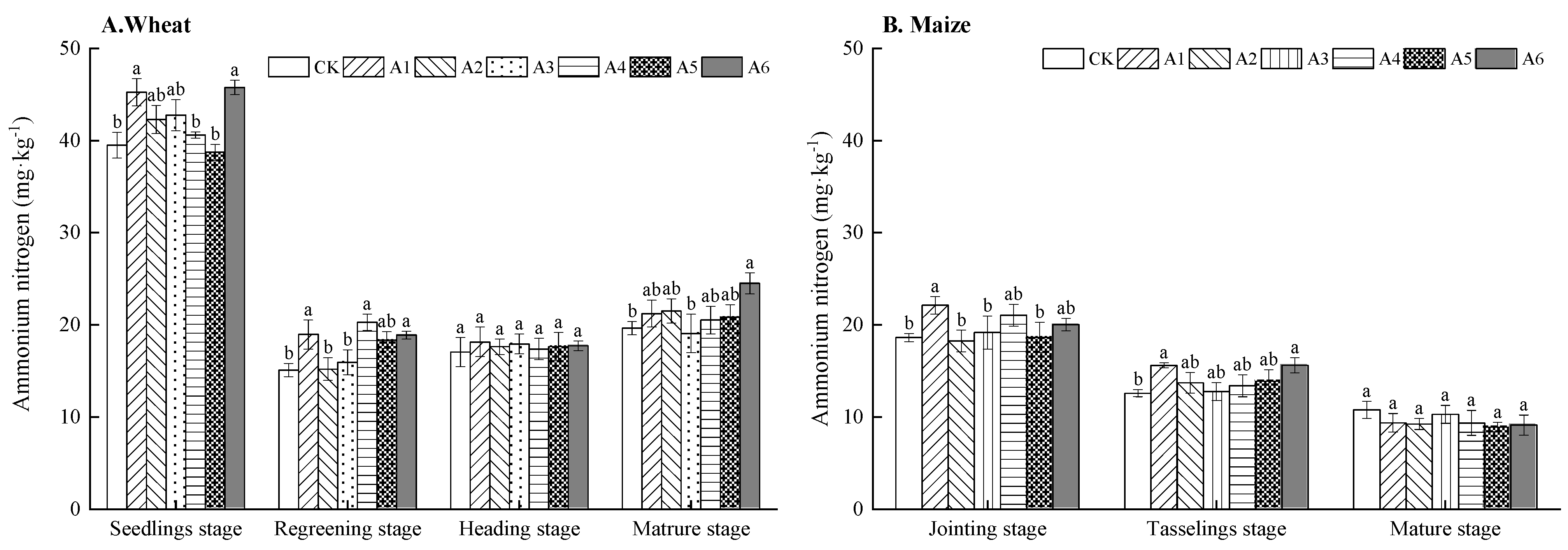
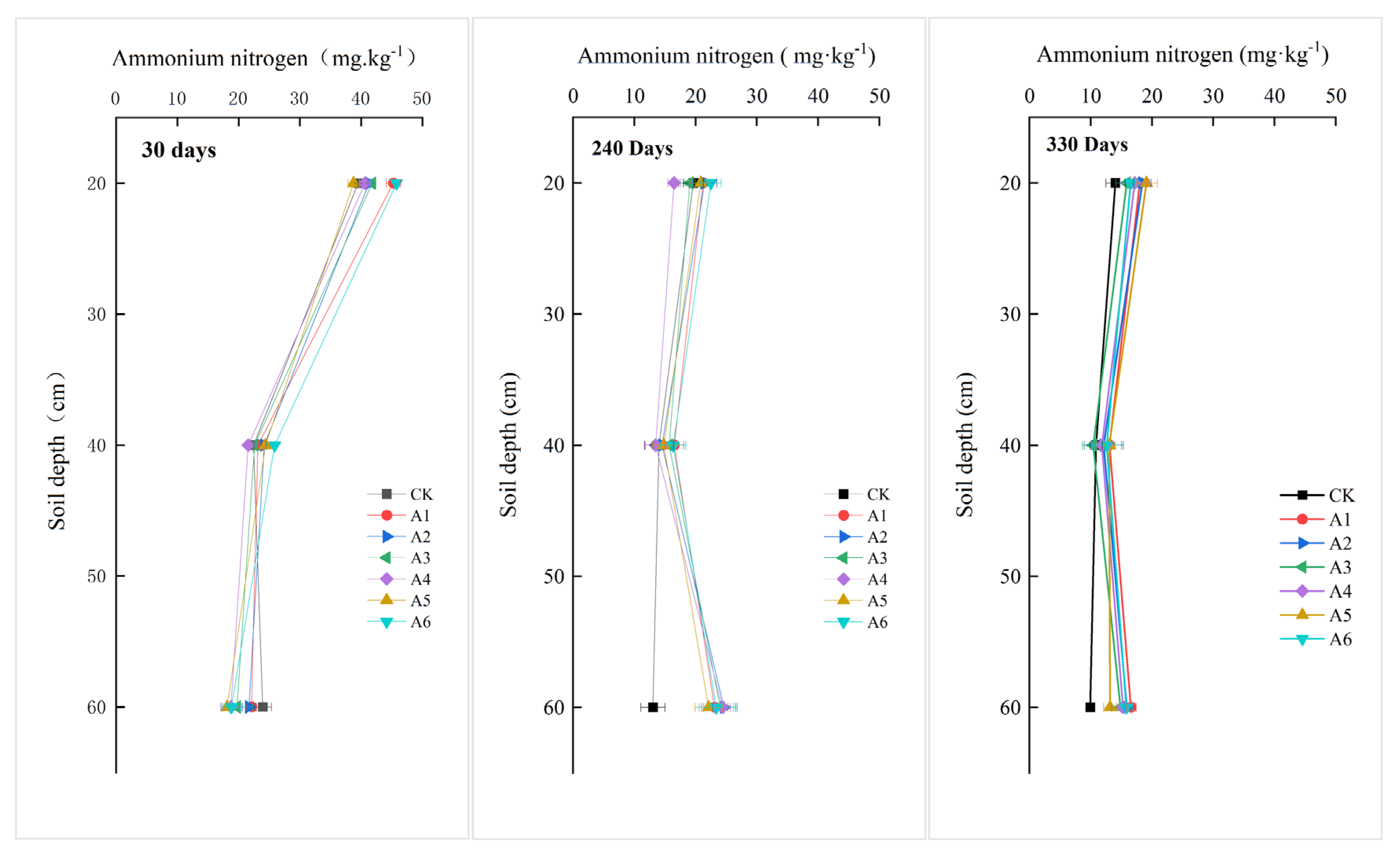
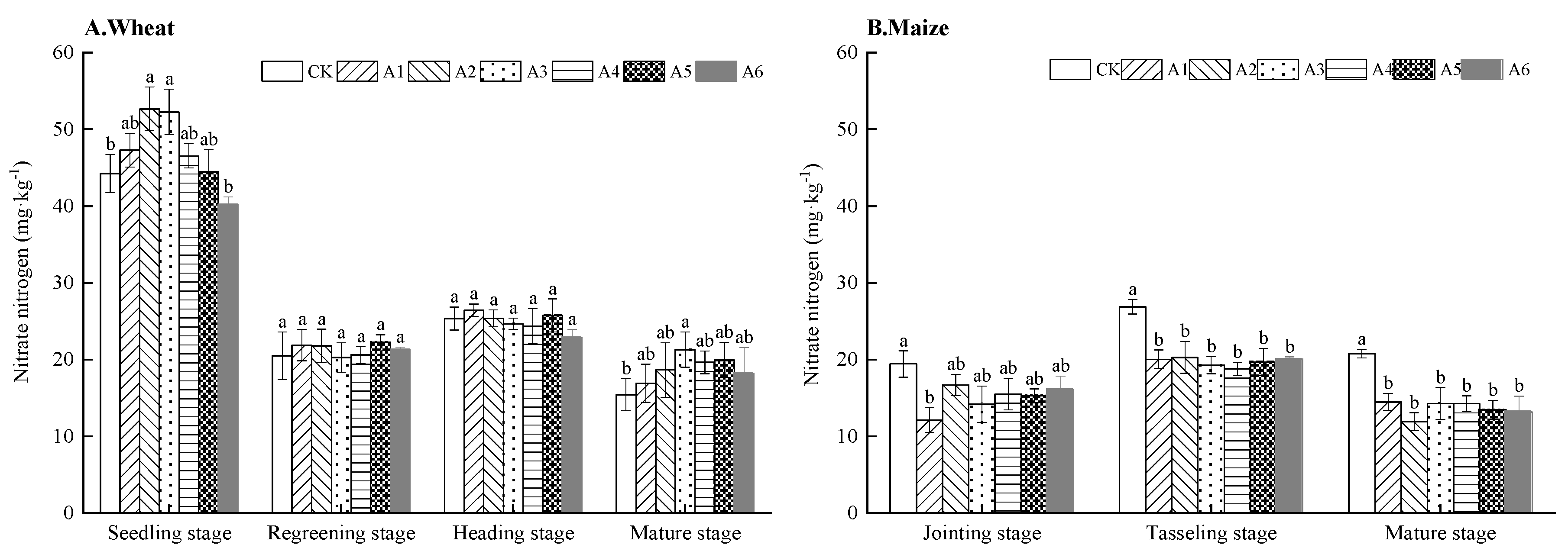
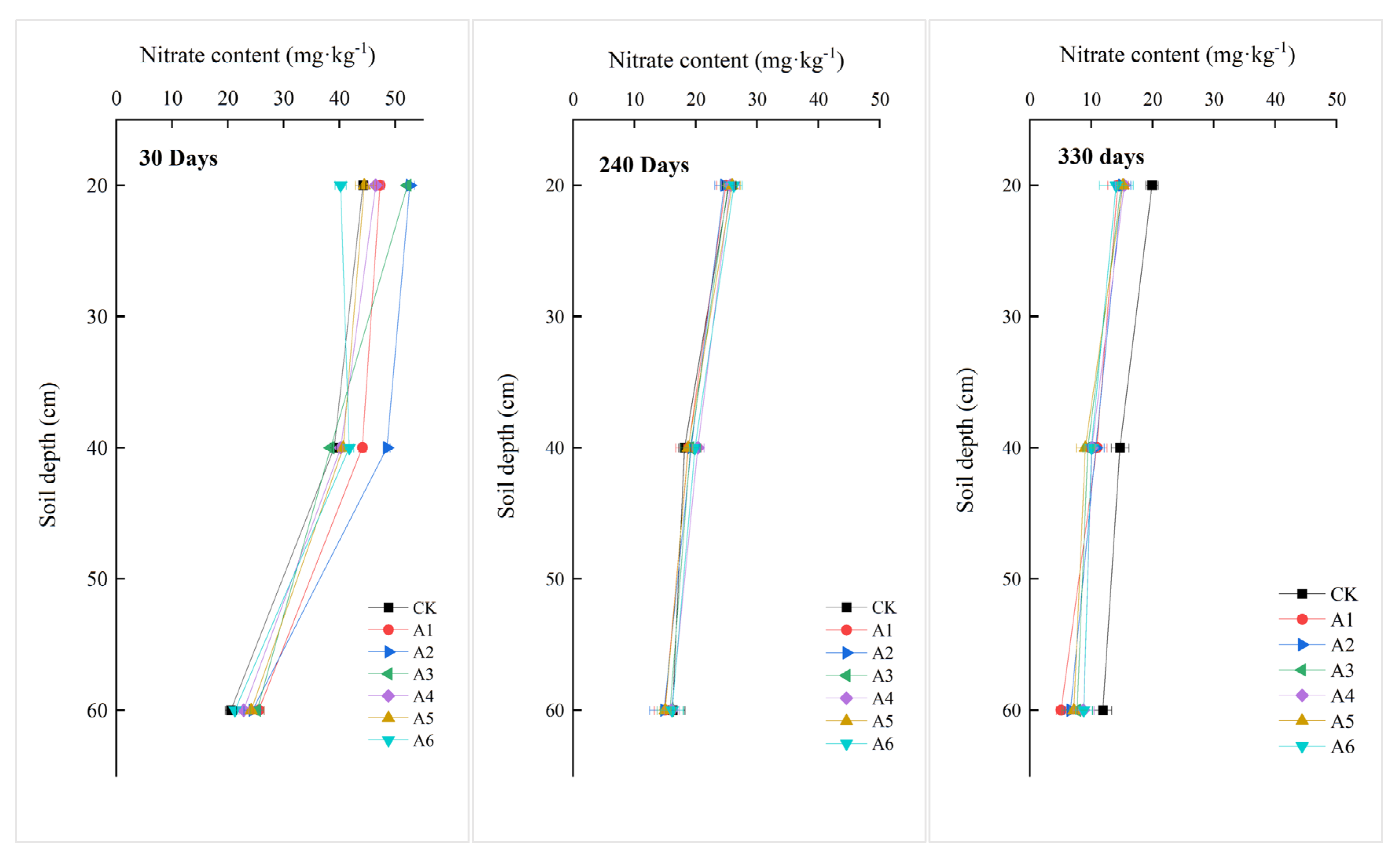


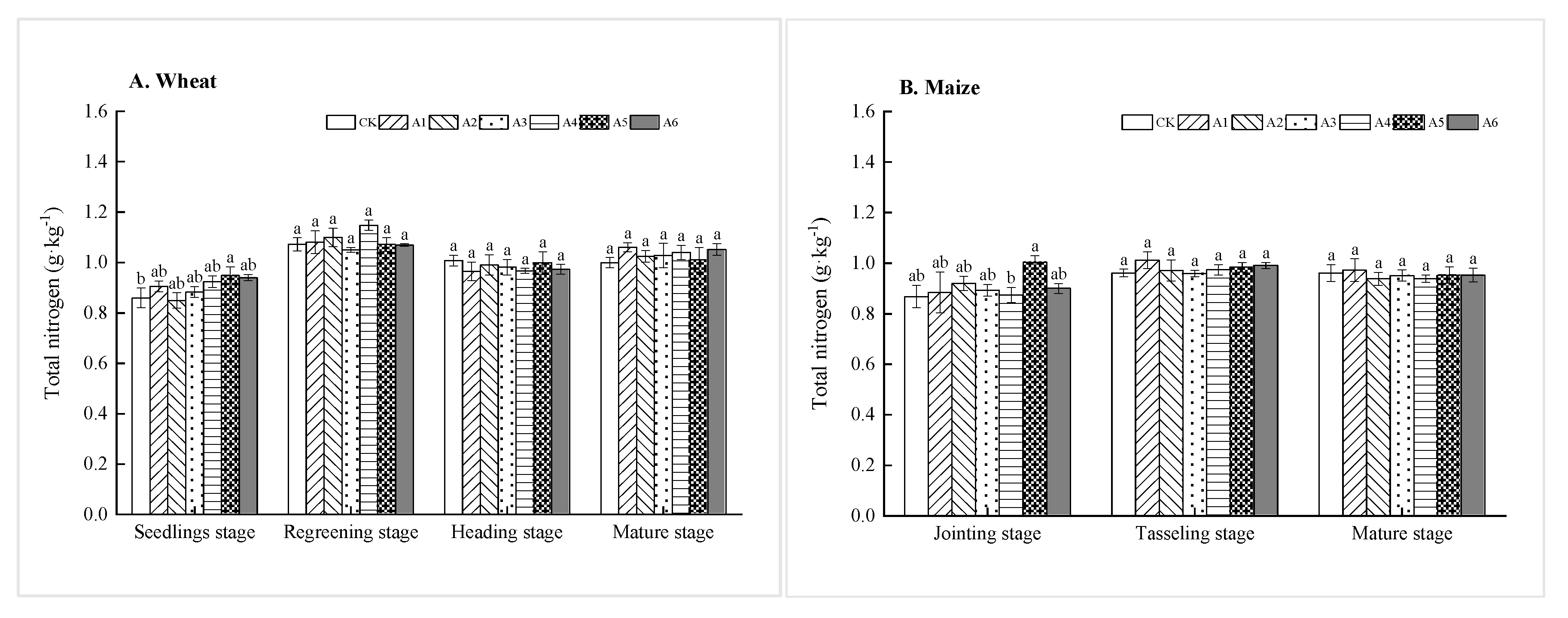
| Treatment | Wheat | Maize | Total | ||
|---|---|---|---|---|---|
| Grain | Straw | Grain | Straw | Biomass | |
| CK | 8637 b | 12,285 b | 9421 b | 10,253 c | 40,596 e |
| A1 | 10,047 a | 14,083 a | 11,240 a | 11,493 b | 46,863 a |
| A2 | 8936 ab | 11,573 b | 11,471 a | 12,355 a | 44,335 b |
| A3 | 9412 a | 14,501 a | 10,916 a | 11,259 b | 46,088 a |
| A4 | 8927 ab | 12,702 ab | 10,181 ab | 10,747 c | 42,557 d |
| A5 | 8823 ab | 12,252 b | 11,290 a | 11,171 b | 43,536 c |
| A6 | 8933 ab | 12,159 b | 10,598 ab | 11,235 b | 42,925 d |
| Treatment | Wheat | Maize | The | ||
|---|---|---|---|---|---|
| Grain | Straw | Grain | Straw | Total | |
| CK1 | 176.2 d | 110.67 d | 112.8 b | 165.1 e | 564.7 c |
| A1 | 225.1 a | 143.7 a | 146.2 a | 202.3 c | 717.2 a |
| A2 | 193.0 bc | 114.6 d | 139.0 a | 221.2 a | 667.7 b |
| A3 | 204.2 b | 146.5 a | 135.1 a | 186.9 d | 672.7 b |
| A4 | 191.9 bc | 128.3 b | 130.4 ab | 228.9 ab | 679.6 b |
| A5 | 187.1 c | 128.7 b | 142.5 a | 221.2 ab | 679.4 b |
| A6 | 201.9 b | 121.6 c | 133.4 ab | 215.7 b | 672.6 b |
| Treatment | ANRE (%) | NAE (kg kg−1) | NHI (%) | NPFP (%) | ||||
|---|---|---|---|---|---|---|---|---|
| Wheat | Maize | Wheat | Maize | Wheat | Maize | Wheat | Maize | |
| CK | 30.75 c | 33.76 c | 6.238 d | 5.472 d | 61.44 a | 40.60 a | 35.99 b | 37.09 c |
| A1 | 64.89 a | 61.55 a | 12.11 a | 12.63 a | 61.04 a | 41.96 a | 41.86 a | 44.25 a |
| A2 | 39.43 b | 66.13 a | 7.48 3c | 13.54 a | 62.75 a | 38.59 ab | 37.23 b | 45.16 a |
| A3 | 57.39 a | 51.11 b | 9.467 b | 11.36 ab | 58.24 a | 41.95 a | 39.22 ab | 42.98 ab |
| A4 | 44.69 b | 65.82 a | 7.446 c | 8.46 c | 59.94 a | 36.30 b | 37.20 b | 40.08 b |
| A5 | 42.80 b | 67.52 a | 7.013 c | 12.83 a | 59.25 a | 39.18 ab | 36.76 b | 44.45 a |
| A6 | 46.04 b | 61.80 a | 7.471 c | 10.11 b | 62.41 a | 38.21 ab | 37.22 b | 41.72 ab |
Publisher’s Note: MDPI stays neutral with regard to jurisdictional claims in published maps and institutional affiliations. |
© 2022 by the authors. Licensee MDPI, Basel, Switzerland. This article is an open access article distributed under the terms and conditions of the Creative Commons Attribution (CC BY) license (https://creativecommons.org/licenses/by/4.0/).
Share and Cite
Cui, X.; Wang, J.; Wang, J.; Li, Y.; Lou, Y.; Zhuge, Y.; Dong, Y. Soil Available Nitrogen and Yield Effect under Different Combinations of Urease/Nitrate Inhibitor in Wheat/Maize Rotation System. Agronomy 2022, 12, 1888. https://doi.org/10.3390/agronomy12081888
Cui X, Wang J, Wang J, Li Y, Lou Y, Zhuge Y, Dong Y. Soil Available Nitrogen and Yield Effect under Different Combinations of Urease/Nitrate Inhibitor in Wheat/Maize Rotation System. Agronomy. 2022; 12(8):1888. https://doi.org/10.3390/agronomy12081888
Chicago/Turabian StyleCui, Xiumin, Jingquan Wang, Jiahui Wang, Yun Li, Yanhong Lou, Yuping Zhuge, and Yuxiu Dong. 2022. "Soil Available Nitrogen and Yield Effect under Different Combinations of Urease/Nitrate Inhibitor in Wheat/Maize Rotation System" Agronomy 12, no. 8: 1888. https://doi.org/10.3390/agronomy12081888






